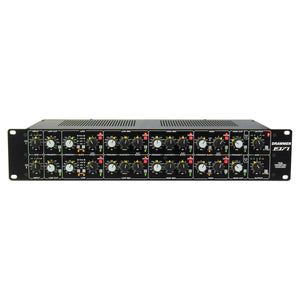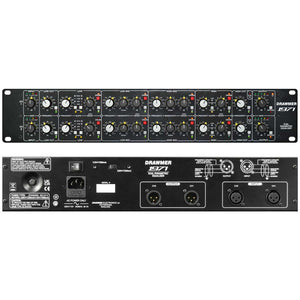Your Cart is Empty





vintage character & crush harmonics
The 1971 offers 2 channels of fully featured 4-band parametric EQ. It has the ability to perform subtle shaping for mastering purposes that require a delicate touch and easy recall, but is just as capable of tonal sculpting, adding the analogue warmth and character that is near impossible to emulate in the digital domain.
A feature that is unique to the 1971 is the CRUSH button. A switchable option available on each band, it adds a fixed time constant, auto gain makeup compressor, whilst also giving a wider rounder bandwidth. In addition it introduces some musically pleasing harmonics. It'll Fatten your bass, enhance the Presence of your mids, and bring out the Shimmer in the top end.
Versatile & Accurate
The versatile design features dual channel precision stepped potentiometers, providing exceptional accuracy for fast and simple recall. All four bands have fully variable frequency controls and each offer a cut and boost function. Additionally, the two mid bands have completely variable filter bandwidth controls, enabling the user to focus on very narrow sections of the audio spectrum, or apply a broad natural sounding filter, and anything in between. Fully adjustable low and high cut filters are also included, ideal for tuning out undesirable signals at the frequency extremes. It also features switchable slopes on the low and high bands, allowing you to alter the focus at the top and bottom frequencies, plus a low peak setting that magnifies the bottom end. The 1971 is perfect for tonal shaping, staying true to the sound of the 70s and ideal for any recording engineer or musician.
Variable Low And High Cut Filters
The 1971 includes fully variable low and high cut filters (10Hz-225Hz and 4kHz-32kHz respectively), which are perfectly suited to honing in on troublesome signals. The beauty of being fully variable is that, unlike fixed frequency filters, it is easy to sweep both controls to find the perfect setting and remove sounds with pinpoint accuracy. This is especially useful when bracketing individual tracks and remove sounds with pinpoint accuracy, for example, where it will be necessary to cut the bass to remove rumble and top to remove hiss, as these undesirable signals will add up as the tracks are layered.
Fully Parametric With Totally Variable Bandwidth
The 1971 is a true ‘parametric’ equaliser, with the four bands having fully variable frequency controls and offer cut and boost of +/-12dB’s. However, unlike EQ’s with a no bandwidth adjustment, or a simple switch, the two mid bands have completely variable filter bandwidth controls enabling the user to focus in on very narrow sections of the audio spectrum or apply a broad natural sounding filter, or, of course, anything in between the two. This makes the 1971 incredibly versatile and capable of modifying everything from subtly fine tuning mixes to tone sculpting problematic recordings.
Switchable Slope Setting
Very few analogue parametric equalisers have an adjustable slope on the low and high band filters, and is yet another feature of the 1971 that allows you to take control of your audio. The filter slopes of the 1971 have been chosen for their musicality, allowing you to adjust the focus of the audio at the bottom and top ends of your recording but not so harsh as to be a very noticeable brick wall filter. At the bottom end filter slopes of 6, 9 and 12dB per octave plus a Peak setting are available, and at the high end 6 and 12dB’s per octave.
The Peak setting adds a narrow bell shape to the 12dB per octave low band filter at the knee frequency just before it rolls off. Especially useful on kick drums, it magnifies and gives extra weight to the hit whilst still filtering out any subsonic junk and without muddying the lower mid. It’ll give your kick an added sense of power and precision.
CRUSH
The effectiveness of the Crush button will vary depending on the frequency band that it is used in and also on the instrument that it is applied to. Use it in the lower frequencies to fatten up the kick, tom or snare drums, bass guitar and other elements of the rhythm section. In the mid frequencies it will help to warm the mix and enhance the presence. It will thicken the guitars and add punch to the percussion, increase the attack of a piano, as well as help to bring out the raspiness in a vocal, for example. At the high frequencies it will bring out the shimmer of cymbals and brighten the string instruments.
The effect is progressive, so as more boost is added to the band the CRUSH effect is more apparent. If you wish to apply much more boost to a band in order to obtain more ‘crush’ be sure to keep an eye on the EQ O/L Led to ensure that the band level doesn’t reach the rails. Use the switch to listen to A/B comparisons to hear the effectiveness of the feature.





